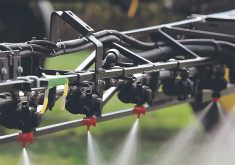KANANASKIS, Alta. – A pest the size of a grain of sand has temporarily shut Alberta out of the export market for seed potatoes.
Two positive cases of the pale cyst nematode out of more than 2,000 samples were diagnosed in Alberta this fall. As a result, the province is quarantined and unable to export seed to the United States, said Vern Warkentin, executive director of the Potato Growers of Alberta.
“We have to do a lot of retesting and the province is closed. We can’t ship anything, no seed potatoes or fresh potatoes with dirt on them until they find the source and do a whole lot more testing,” he said Nov. 14.
Read Also

University of Manitoba hires potato researcher
A new research chair position at the University of Manitoba will tackle sustainability in the potato industry.
“It will be open but right now we are in a political and scientific process,” he said.
Nematodes are on a quarantine pest list because in high concentrations they can cause a significant yield loss of up to 80 percent. There is no impact on the potato, which can be eaten.
Vancouver Island and Newfoundland have been quarantined for four decades because of the presence of this pest. Some were found in Idaho and Quebec last year.
The Canadian and U.S. governments agreed that potatoes moving in either direction had to be tested, but most of the seed comes from Canada. Mexico also buys Canadian seed and its purchases are on hold until the situation is resolved.
Pale cyst nematode and golden nematode are roundworms that attack field crops like potatoes, tomatoes and eggplants. Infested potato fields will be wilted and discoloured.
Nematodes attack the roots of the potato and can last in the soil as cysts for up to 25 years.
The female larvae enters the root, feeds and swells to the point where its body breaks the root. Male larvae fertilize the female, whose body hardens after it dies and becomes a cyst containing up to 500 eggs.
The cysts are spread by movement of the soil through machinery or vehicles carrying soil or tubers carrying soil.
The Canadian Food Inspection Agency tests for the pest by gathering soil samples from the edges of fields where seed potatoes were grown. If a positive is found, more tests are done on the field.
Alberta grows about 10,000 acres of seed potatoes.















